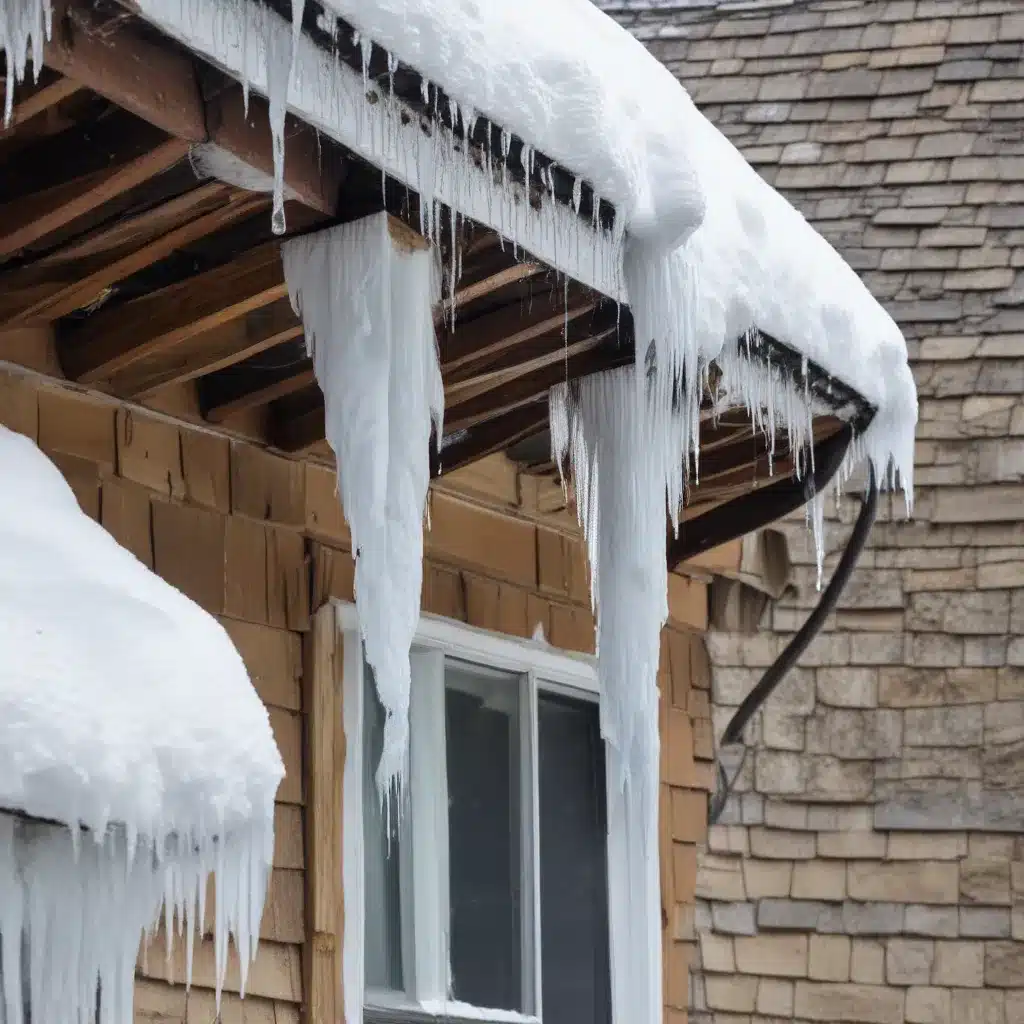
Understanding Ice Dams and Their Impact
Ice dams are a common problem that can wreak havoc on your roof during the winter months, especially in northern climates with heavy snowfall. These ridges of ice form at the edge of your roof, preventing melting snow from properly draining off. As the water backs up behind the dam, it can seep under the shingles and into your home, leading to costly water damage, mold, and even structural issues.
The primary cause of ice dams is nonuniform roof temperatures. When the upper portions of your roof are above freezing while the lower edges remain below 32°F, the snow will melt and refreeze, creating the dam. This temperature difference is often the result of heat escaping from your home, traveling up through the attic and warming the roof surface.
The consequences of ice dams can be severe:
- Water damage to ceilings, walls, insulation, and other interior areas
- Growth of mold and mildew, which can cause respiratory problems
- Potential structural issues if the water penetrates deep into the building envelope
- Icicles forming at the roof edge, which can be a safety hazard
Preventing Ice Dams Before They Form
The key to avoiding ice dam damage is to take proactive steps to maintain a cold roof surface and prevent the temperature differences that lead to their formation. Here are some effective strategies to try:
Seal Air Leaks in the Attic
One of the primary culprits behind ice dams is warm air escaping from the living space below and entering the attic. This can happen through various openings and gaps, such as around light fixtures, plumbing pipes, chimneys, and attic hatches. Take the time to locate and seal these air leaks using caulk, foam, or other appropriate sealants. This will help keep the attic temperature low and prevent heat loss that could melt snow on the roof.
Improve Attic Insulation
Inadequate insulation in the attic is another major contributor to ice dam formation. Upgrading your attic insulation to an R-value of at least R-40 (around 12-14 inches of fiberglass or cellulose) can make a big difference. Blown-in insulation is often more effective than batt insulation, as it fills gaps and cavities more thoroughly. Consider hiring a professional insulation contractor if you’re not comfortable performing this task yourself.
Enhance Attic Ventilation
Proper attic ventilation is crucial for maintaining a consistent, cold roof surface. Aim for a ventilation area of about 1 square foot per 300 square feet of ceiling area, with half the vents located low in the soffit and half high at the roof’s peak. This will help draw in cold outside air and expel warm, moist air from the attic, reducing the risk of snow melting and refreezing.
Seal and Insulate Attic Ductwork
Leaky or poorly insulated ductwork in the attic can also contribute to heat buildup and the formation of ice dams. Seal any gaps or cracks in the ductwork using mastic or metal tape, and make sure the ducts are properly insulated to prevent heat loss.
Consider a Metal Roof
If you’re in the market for a new roof, consider opting for a metal roof system. Metal roofs are less prone to ice dam issues because they have a smoother surface that allows snow and ice to slide off more easily. The reflective properties of metal roofing materials can also help prevent excessive heat buildup that leads to melting and refreezing.
Monitor and Remove Snow Buildup
Even with these preventative measures in place, heavy snowfall can still lead to ice dam formation. Regularly monitor the roof and consider hiring a professional to safely remove snow and ice buildup, especially from vulnerable areas like roof valleys and edges. This can help minimize the risk of water infiltration and damage.
Dealing with Existing Ice Dams
If you already have an ice dam forming on your roof, it’s important to address it promptly to prevent further damage. Attempting to remove the ice dam yourself can be dangerous and potentially cause more harm to your roof. Instead, consider these strategies:
Call in a Professional
Hire a reputable roofing contractor to safely remove the ice dam using a specialized steamer or other safe method. They have the proper equipment and expertise to melt the ice without damaging your roof.
Apply Heat Cables
Another option is to install self-regulating heat cables along the roof’s edge and in the gutters. These cables will melt the ice and prevent new dams from forming, providing a more long-term solution.
Use Calcium Chloride
As a temporary fix, you can try using calcium chloride ice melt products to create channels through the ice dam, allowing water to drain. However, this method should be used with caution, as the chemical can potentially damage your roof and landscaping.
Preparing for the Next Winter Storm
By taking proactive steps to maintain a cold roof and prevent ice dam formation, you can safeguard your home and minimize the risk of costly water damage. Remember to consult with a professional roofer or insulation contractor if you need assistance with any of these strategies.
At Roofers in Northampton, our team of experienced roofing experts is here to help you prepare your home for the winter months and address any ice dam-related issues that may arise. Contact us today to learn more about our comprehensive roofing services and how we can help protect your property from the damaging effects of ice dams.

